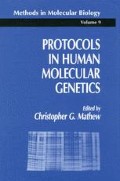Abstract
The majority of human-rodent somatic cell hybrids lose human chromosomes in a more or less random manner. It is possible to obtain a panel of hybrids in which each contains a unique subset of human chromosomes. In principle, human genes can be mapped in such hybrids by looking for correlation between the presence of a particular protein product or DNA sequence and a particular human chromosome. Hybrids containing well defined fragments of human chromosomes can then be used for regional localization. The availability of DNA from well characterized hybrids allows the rapid assignment of a newly cloned human sequence without the expertise and expensive equipment currently required for analysis of direct in situ hybridization to metaphase spreads or flow sorting of human chromosomes.
Access this chapter
Tax calculation will be finalised at checkout
Purchases are for personal use only
References
Abbott, C, West. L., Povey, S., Jeremiah, S., Murad, Z, Discipio, R., and Fey, G (1989) The gene for human complement component C9 mapped to chromosome 5 by polymerase chain reaction. Genomics, 4, 606–609.
Edwards, Y., Saburo, S., Schon, E., and Povey, S. (1989) The gene for human muscle-specific phosphoglycerate mutase, PGAM2, mapped to chromosome 7 by PCR Genomics 5, 948–951.
Jeremiah, S., Abbott, C. M., Murad, Z., Povey, S., Thomas, H. J, Solomon, E., Discipio, R., and Fey, G H. (1990) The assignment of the genes coding for human complement components C6 and C7 to chromosome 5. Ann. Hum. Genet. 54, 141–147.
Tolan, D. R. and Penhoet, E. E. (1986) Characterization of the human aldolase B gene Mol. Biol. Med. 3, 245–264.
Abbott, C, Povey, S., Vivian, N, and Lovell-Badge, R. (1988) PCR as a rapid screening method for transgenic mice Trends in Genet 4, 325.
Author information
Authors and Affiliations
Editor information
Editors and Affiliations
Rights and permissions
Copyright information
© 1991 The Humana Press Inc., Clifton, NJ
About this protocol
Cite this protocol
Abbott, C., Povey, S. (1991). The Use of the Polymerase Chain Reaction in the Mapping of Human Genes Using Somatic Cell Hybrids. In: Mathew, C.G. (eds) Protocols in Human Molecular Genetics. Methods in Molecular Biology, vol 9. Springer, Totowa, NJ. https://doi.org/10.1385/0-89603-205-1:141
Download citation
DOI: https://doi.org/10.1385/0-89603-205-1:141
Publisher Name: Springer, Totowa, NJ
Print ISBN: 978-0-89603-205-7
Online ISBN: 978-1-59259-496-2
eBook Packages: Springer Protocols

